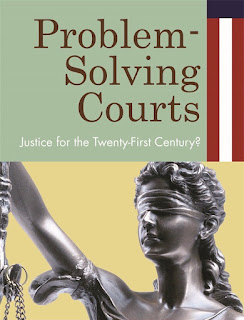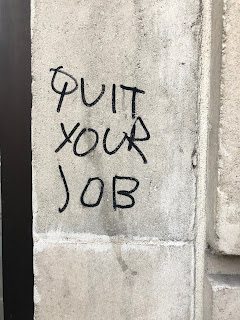Twenty Years
This year marks the 20th anniversary of the
Center for Court Innovation. We’ve
got a lot going on at the moment, so we are choosing not to mark this
anniversary with a capital campaign or a gala fundraiser or anything like
that.
But we would be remiss if we didn’t pause for a minute or
two to acknowledge how far we’ve come since 1996. So over the next month or so, we will post a few features on
our website – videos, photo galleries, testimonials – to celebrate our history.
I have been blessed to work at the Center for Court
Innovation for all 20 years of its existence. Back in 1996, the Center had only a handful of assets – the
vision of our founding director John Feinblatt, the reputation of the Midtown Community Court, a strong relationship with the New York State court system,
and the entrepreneurial energy of a core group of a couple dozen committed
staffers. Today, we are an
organization of several hundred people, with operating programs in all five
boroughs (plus Newark plus Syracuse plus Westchester), a research department
with an international reputation, and a consulting practice that takes us
around the world providing assistance to justice reformers.
I wish I could say that our growth has been the product of a
carefully crafted strategic vision that we have pursued with rigorous
discipline. In truth, our expansion
has been fueled primarily by luck and opportunism (in the best sense of the
word, I hope).
As we have grown, we have had to adapt and change. I think it is fair to say that we have
become a more hierarchal and bureaucratic institution. If I am honest, I feel some ambivalence
about this, but we have found it impossible to run an operation like ours
without introducing formal structure and policies and procedures.
We have also had to respond to changing conditions in the
world around us.
We were born at a moment when conservative ideas about
criminal justice were in ascendance in the US. The country was in the middle of a 40 year expansion of the
use of incarceration. New York had a Republican mayor and governor. Against this backdrop, we attempted to
make the case for meaningful alternatives to incarceration, increased use of
data, respectful treatment of both defendants and victims, and community
engagement by justice agencies.
In many respects, we are still making the case for these ideas. But the world around us has
changed. There is a growing
recognition, across a fairly broad political spectrum, that the US has gone too
far in the use of incarceration.
There is also an increasingly powerful movement, both outside and within
the justice system, that is focused on addressing our country’s legacy of
racism and the continued disparities in how people of color are treated.
At the Center, we have changed with the times. When we started, our work was focused
primarily on what happens after someone has been adjudicated, providing judges
with alternatives to jail sentences and fines (and, in some cases, nothing at
all). In recent years, we have been placing more and more attention
on the pre-adjudicatory process.
This includes offering supervised release to reduce the use of bail and pre-trial detention and diversion programs to help keep young people out of the
system entirely. And it includes
making a deeper investment in crime prevention, including providing a broad
range of community-based youth development initiatives and fighting violence
through street outreach and community education campaigns.
Acknowledging that the justice system can do a better job of
creating a level playing field, the Center has placed an institutional bet on
two other key areas of practice: access to justice and procedural fairness. In truth, both of these
issues have been with us from the start: our first project, the Midtown
Community Court, was, after all, an effort to bring justice back to the
neighborhood level while providing individual attention to each case. But in recent months, we have tried to
kick our work in these areas into a different gear, testing new ways of helping
unrepresented civil litigants and spreading the concept of procedural justice
to criminal courts across the country.
Even as we have adapted to changing times, some things have
remained constant at the Center for Court Innovation.
Our institutional culture is what has enabled us to endure
and expand over the past two decades.
It is always difficult to talk about the culture of a place without
lapsing into abstraction or self-flattery. But if I had to highlight the key
values of our agency that I have tried hard to protect and preserve over the
years, I would point to these six:
1. Creativity – We are not an Internet start-up. We don’t have foosball tables or
pinball machines in any of our offices.
But we do have the audacity to put “innovation” in the name of our agency. Along with that comes a clear
institutional mandate to test new ideas and to try to make a unique
contribution to the world that is different from other agencies.
2. Practice – Our contributions to the world are reality-tested. We run programs that work with
challenging populations – chronic misdemeanants, parolees who have committed
serious offenses, and traumatized victims, among many others. And we work in challenging
environments, including crime-plagued neighborhoods and overwhelmed centralized
courthouses. We know how difficult
it is to change broken systems and to repair damaged neighborhoods because we
are doing this work alongside our partners in the justice system and in the
community each and every day. We think our grounding in practice lends
nuance and credibility to our thinking about reform.
3. Modesty – As much as possible, we have tried to avoid making
grandiose claims and setting utopian goals. Instead, we have sought to achieve more modest aims –
transforming specific neighborhoods and particular courtrooms and discrete populations
of victims and defendants. We think
that there is virtue in starting small and providing carefully targeted
interventions. We also believe
that successful pilot programs can lead to major change if you are patient
enough to see them through. (Yes, I recognize the irony that I am bragging
about our modesty.)
4. Details – We believe that the little things matter
enormously. This is why we work
hard to repair conditions of disorder at the neighborhood level. This is why we are focused on how
judges and attorneys and police officers communicate with the public. This is why we spend time thinking about
the wording of documents and the architecture of spaces. Sweating the details of implementation
is one way we demonstrate our commitment to excellence.
5. Diversity – Despite being in the legal reform business
(broadly defined), we have never been an agency staffed primarily by lawyers
from elite schools. Rather, we
have sought to attract a diverse array of people to the challenge of justice
reform. This includes hiring a
diverse staff along the lines of race, gender, sexuality, religion, ethnicity, political affiliation, etc. It also includes bringing together people of disparate professional
training and background – not just lawyers but social scientists and
technologists and victim advocates and social workers and community organizers
and journalists. At the end of the
day, all we offer to the world is the strength and depth of our team.
6. Reflection – The act of reflection is built into our
daily work. When our technical
assistance team makes site visits to other jurisdictions, they don’t come
pretending that they have all the answers. And they don’t come to conduct didactic lectures. Rather, they come to ask questions, to listen
closely to the answers, and to help local leaders figure out how to solve local
problems. In a similar vein, we engage
our research team in examining our own operating programs on a regular basis to
help us find new ways to improve our practice.
The values I have listed here are not the only ones that
matter to us. I’m sure if you
asked a dozen Center for Court Innovation staffers, you’d hear them point to
our commitment to love and kindness, our belief in the human capacity for
change, our non-ideological and non-partisan approach to reform, our business model of working in partnership with government, and a
variety of other elements that make us unique. But these are the primary values that have guided my efforts
on behalf of the Center for Court Innovation.
I am enormously proud of what we have accomplished over the
past two decades. I am mindful of
all of the partners we have relied upon along the way – there are so many individuals
and agencies that it is impossible to do justice to them all here. Finally, I am grateful to work
alongside colleagues who are decent and fair and funny and committed to making
the world a better place.
I am looking forward to seeing what the next twenty years brings...


